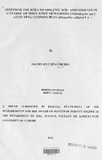| dc.contributor.author | Muiru, David M | |
| dc.date.accessioned | 2013-05-09T14:11:13Z | |
| dc.date.available | 2013-05-09T14:11:13Z | |
| dc.date.issued | 2003 | |
| dc.identifier.citation | Muiru, D.M(2003). Assessing the role of organic soil amendments in control of root-knot Nemadodes (Meloidogyne spp.) affecting common bean (Phaseolus Vulgaris L.) | en |
| dc.identifier.uri | http://erepository.uonbi.ac.ke:8080/xmlui/handle/123456789/20952 | |
| dc.description | Msc- Thesis | en |
| dc.description.abstract | A study was undertaken to determine the role of organic amendments in supressing rootknot
nematodes The organic amendments used in the study included chicken and cow
manures and leaves of Mucuna pruriens (velvetbean), Azadiracta indica (neem) and
Tagetes minuta (marigold).
An experiment was established to determine the effect of organic amendments on damage
caused by nematode to beans. The materials were applied fresh (undecomposed) at the
rate of 5% (w/w) in 5kg pots with untreated soil and soil treated with carbofuran as
controls. The soil was infested with 6000 nematode eggs per pot. All the organic
amendments reduced galling and reproduction of root-knot nematodes in beans. Galling
indices ranged from1.5 to 3.8 (on a scale of 1-9) in soils amended with the organic
materials compared to 6.3 in the control. Chicken manure was the most effective in
reducing galling and reproduction of root-kot nematodes followed by A. indca and T.
minuta, with cow manure being least effective. All the organic amendments increased
plant growth, with chicken manure being superior to the other amendments. Carbofuran
(non-fumigant nematicide) was the least potent of all the treatments.
A laboratory experiment was conducted to determine the effect of water extracts of the
organic amendments on the mobility of second-stage (J2s) Meloidogyne juveniles. The
materials were decomposed in water and their extracts used to treat Meloidogyne
juveniles. Counts of inactivated (immobile) J2s were taken on an hourly interval for five
hours. The extracts immobilized more than 90% of the J2s treated, with the exception of
xi
the extract from cow manure, which immobilized 36% in five hours. All the extracts
immobilized a higher proportion of J2s than carbofuran.
All the amendments increased the available NH4-N, P ands pH with chicken manure
giving the highest levels. Correlations between NH4-N and nematode egg masses (r= -
0.85) and juvenile population (r= -0.55) were negative suggesting the involvement of
NH4-N in nematode suppression. Phosphorous was negatively correlated to egg masses
(r= -0.79) and juvenile population (r= -0.44) indicating that it plays a role in nematode
suppression. Fertilizer-treated soil (galling= 3.3 at 45 DAI) had a better control level than
the controls (galling = -5.8 at 45 DAI) indicating that nutrients have a role to play in
nematode management.
Microbial biomass carbon (MBC) and microbial biomass nitrogen (MBN) and microbial
activity were stimulated by all the amendments with chicken manure and Tagetes giving
the highest level of stimulation. MBC and MBN were negatively correlated to nematode
egg masses (r= -0.68 &-0.81), and juveniles (r= -0.66 &-0.23), respectively.
Most of the organic amendments encouraged a high population of Bacillus spp., which
were used as the indicators of the presence of biocontrol agents with chicken manure and
Tagetes being the best stimulants. Bacillus showed a high potential in reducing nematode
egg masses since they were highly negatively correlated (r= -0.94). | en |
| dc.description.sponsorship | University of Nairobi | en |
| dc.language.iso | en | en |
| dc.subject | Organic soil | en |
| dc.subject | Root-knot nematodes(Meloidogyne spp.) | en |
| dc.subject | Common bean (Phaseolus vulgaris L.) | en |
| dc.title | Assessing the role of organic soil amendments in control of root-knot Nemadodes (Meloidogyne spp.) affecting common bean (Phaseolus Vulgaris L.) | en |
| dc.type | Thesis | en |
| local.publisher | Department of soil science, University of Nairobi | en |

